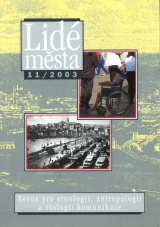Bezdomovci v Banskej Bystrici a v Českých Budějoviciach v 90-tych rokoch 20. storočia z pohl'adu urbánneho geografa
DOI:
https://doi.org/10.14712/12128112.4308Abstrakt
The transformation movements in post-socialist societies have naturally had an impact on the changes in the social and spatial fabric of towns. On the one hand, there was a change in the case of such people who extended the improvement of their social and economic position into a progressive transformation of their quality of housing. On the other, there is a group of population whích has been forced to lower its standard of housing are it was entirely stripped of it (the homeless people) due to the direct or indirect impact of transformation changes. The situation in the social sphere as well as homelessness in the towns under observation displays some similar and some specific features. The original situation was quite similar: the overriding part of urban population was in a "levelled" social situation, while social differentiation and social polarisation lagged behind. On the other hand, the proportion of the population of the lowest social groups was in Banská Bystrica higher than in České Budějovice. This state of affairs can be most visibly documented by the existence of specific Romany housing habits in special settlements in Banská Bystrica, which does not exist in such a form in České Budějovice. ln general, similar features can also be found in the sphere of population development in the socialist era, when both towns under examination attracted a large number of people in the productive age from the country and small towns. This was reflected in a large-scale construction of "faceless" housing projects with a concentration of a population heterogenous in terms of cultural and family habits. This resulted in weak neighbourly and community relationships as well as suitable conditions for the creation of socially pathological phenomena, including the subsequent emergency of homelessness. Both the population structure and ethnic structure were modified. The population structure of České Budějovice is demographically older. Our interest mainly focuses on the lower proportion of Romanies in České Budějovice. After 1990, one could see a distinctly different development in the social and economic sphere in the towns under observation. The development in České Budějovice largely avoided any major social disruptions. On the other hand, there were some social upheavals in Banská Bystrica due to mass lay-offs in a number of businesses. Above all, this affected "problem individuals." The outlined, modified conditions in the sphere of social situation in the towns under examination caused the phenomenon of homelessness to acquire a distinctive character in the 1990s. ln both towns, we can divide the homeless people into three groups, while the basic difference between the two cities can be observed in the proportion of individual groups in the entire phenomenon of homelessness: 1. "Typical homeless people" - the socially weakest people who are unable to settle their situation - typical socially marginal groups, divorced people, alcohol and drug addicts, the "bankrupt", inmates of children's asylums, former prisoners - the latter are frequent from the Romany environment. These were mostly people from the original town and its close vicinity. 2. "Transit homeless people" - refugees, asylum seekers, migrating homeless people. These are the temporary homeless, but some of them will become typical homeless people or professional homeless people. 3. "Professional homeless people" - they can originate from both of the former two groups. It is impossible to delineate a clear-cut border between them. These are the people with specific features of character ("the freethinkers"), who indulge in the life outside the social framework, binding social conventions and "real" values. In Banská Bystrica, there was also a complete lack of the transit homeless people, while there was a domination of typical homeless people. In České Budějovice the proportion of individual groups of homeless people was more balanced.
Stahování
Publikováno
Jak citovat
Číslo
Sekce
Licence

Tato práce je licencována pod Mezinárodní licencí Creative Commons Attribution-NonCommercial-NoDerivatives 4.0.


